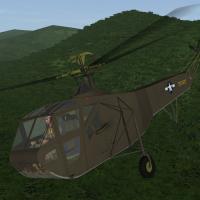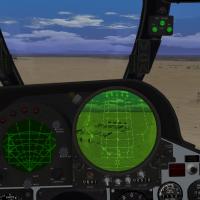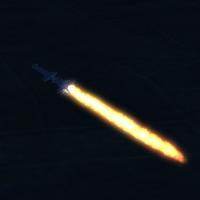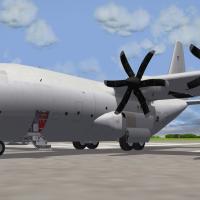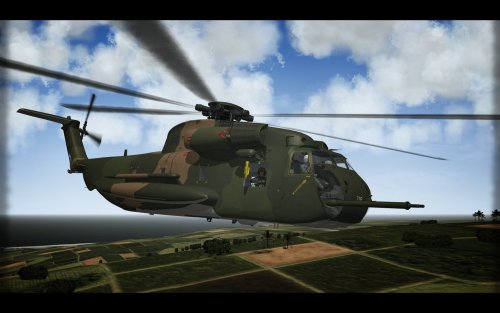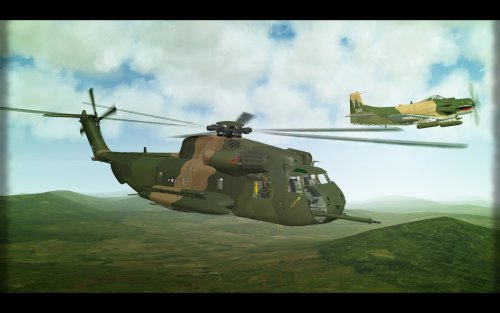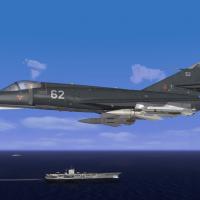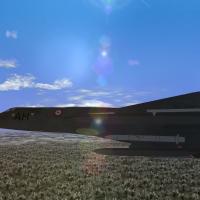-
Content count
9,690 -
Joined
-
Last visited
-
Days Won
104
Content Type
Profiles
Forums
Calendar
Gallery
Downloads
Store
Everything posted by 76.IAP-Blackbird
-

Sukhois
76.IAP-Blackbird replied to 76.IAP-Blackbird's topic in Thirdwire: Strike Fighters 2 Series - Mods & Skinning Discussion
Today Guys, I would like to share this kind of Development Update with you. We are working on the Su-22 Variants that were used in the Iran Iraq conflict, the russian builds and the Peru versions. As you read those news, we are working on those birds. Pits are WIP right now, so the skin polishing and 3D model debuggin is going on right now For now, some pics of the Su-22 And here the early version with two wingfences only and the "fat ass" from the Su-7 fuselage A render of the Airbrakesystem- 471 replies
-
- 6
-

-

-
- sf2 fitter
- su-17m fitter
-
(and 3 more)
Tagged with:
-

What If Screenshot Thread.......
76.IAP-Blackbird replied to Dave's topic in Thirdwire: Strike Fighters 2 Series - Screen Shots
-

Il2 Game update 2.012 released
76.IAP-Blackbird posted a topic in IL-2 Series / Pacific Fighters / Cliffs of Dover: General Discussion
Dear pilots, today is a real milestone for the project - we just released the 2.012 update, one of the biggest ones ever. We already told you in Dev Blogs what it will bring, but here's the quick overview. 1. New Hs 129 B-2 Collector Plane with many unique features and very varied weaponry. 2. Kuban map available in three seasons (Spring, Summer and Autumn). 120 thousands of square kilometers large (400 x 300 km), the biggest map in the new generation of IL-2 to date. Please note that the work on improving the AI is underway and it is not very proficient in mountain flying, we will work on it this Autumn. The map is huge, so we'll be fixing the issues that may be found in Early Access. 3. Updated FM for all aircraft. The total list of FM changes is very long, you can check it out below. 4. Together with the Kuban map, we're releasing many AI controlled ships: G-5, G-5 project 213 and S-38 torpedo boats, Type A landing barge, Type Щ (Shch) series X and Type IIB submarines, Soviet Type 7 destroyer. 5. Completely new shadow tech that allowed us to increase the shadows resolution in the cockpit, render outside shadows several times further, show the own plane shadow on the ground and make tree shadows more realistic. Here's the complete change list: 1. Henschel Hs 129 B-2 Collectors Plane is added to the project and all Battle of Kuban owners can fly it now; 2. All three seasons of the Kuban map (Spring, Summer and Autumn) are added to the project and any owner of the sim can fly over them in multiplayer while Battle of Kuban owners can access them in any game mode; 3. The new shadows technology CSM was added to the game; 4. The new shadow quality option in the game graphics settings governs the shadows resolution, their visibility distance and which objects can cast shadows; 5. Thanks to the new shadow tech CSM, shadows in the cockpit became sharper at high quality settings; 6. Thanks to the new shadow tech CSM, all the cockpit objects cast shadows instead of just the canopy elements; 7. Thanks to the new shadow tech CSM, the aircraft shadow on the ground is visible from inside the cockpit at high quality settings; 8. Thanks to the new shadow tech CSM, object shadows are visible at twice distance as before at high quality settings; 9. Thanks to the new shadow tech CSM, trees now cast correct shadows on all objects; 10. The aerodynamics modeling of the aircraft tail became more detailed, resulting in MANY improvements and changes (the full list is available here): Spoiler Main changes: 10.1. All aircraft stability along the pitch and yaw axes have been reworked. Planes reaction to control surfaces input became much less volatile and closer to reality. 10.2. Aircraft controllability was tuned simultaneously with the stability in the same control channels. Control surfaces inputs in different flight conditions became more realistic. Aircraft handling became much less 'sharp' and more convenient and predictable. 10.3. Roll 'dipping' after a full rudder input has been significantly decreased for all aircraft. Flat turns, coordinated side-slipping (straight banked flight with full rudder input for braking) and other maneuvers with side slipping motion at large angles became much closer to real ones. 10.4. Time of stabilizers and trimmers shift from end to end is now close to realistically possible. 10.5. Trim effectiveness has been corrected for several aircraft to correspond to the updated balance boundaries. 10.6. Load increase of the control surfaces has been corrected as the speed increases, changing aircraft controllability at various flight speeds and making them function closer to real data. 10.7. Because of the tuned stability characteristics, aircraft lose directional stability in an event of horizontal surfaces destruction. 10.8. Because of the tuned stability characteristics, aircraft lose lateral stability in an event of vertical surfaces destruction. 10.9. Because of the tuned controllability and stability and additional stall tuning, aircraft stall behavior changed. An aircraft sticks less in a spin, spin recovery became easier and more predictable. Therefore, an aircraft behavior during stall and spin became closer to the real thing. If there was a specific spin data available for an aircraft, it was taken into account to make the FM even more accurate (additional details follow below). 10.10. Thanks to aircraft stability and controllability changes taxiing and take-off and landing runs became more predictable and controllable. 10.11. Run-down time of the freely rotating landing gear wheels has been decreased by increasing friction values in the wheel bearings. 10.12. Landing gear brakes friction has been increased, making the aircraft stopping and holding while revving the engine(s) easier. 10.13. Air flow at beyond-stall AoA is now modeled better, making bobbling and shaking during a stall more realistic. 10.14. Control surfaces buffeting values at high flight speeds have been tuned: amplitudes were lowered, frequencies increased. 10.15. Flight stick and pedals shifting speed became slower even more due to increased load at high flight speeds. 10.16. Oscillation delay time of the sideslip indicator (the small ball) has been corrected. 10.17. Aircraft fragments behavior (unnaturally smooth fall of detached ailerons, elevators, rudders, etc.) has been corrected, especially at high speeds. 10.18. Mouse control quality has been improved significantly. Additional clarification on fixes of Soviet planes: LaGG-3 series 29: 10.19. Landing gear physics model has been revised. Now the aircraft is much less prone to 'circling', it is now possible to turn at 15-25 km/h speed without using brakes. 10.20. Take-off characteristics in crosswinds improved. 10.21. Pedals load at various flight conditions has been corrected (significantly increased at low speeds and significantly decreased at high speeds). 10.22. Pitch balance and its dependence on the flaps have been corrected. 10.23. Rudder, elevator and ailerons trim shift time from end to end increased from 6 to 8 seconds. 10.24. Elevator trim effectiveness has been decreased. La-5 series 8: 10.25. Landing gear physics model has been revised. Now the aircraft is much less prone to 'circling', it is now possible to turn at 15-25 km/h speed without using brakes. 10.26. Pedals load at various flight conditions has been corrected (increased at low speeds and decreased at high speeds). 10.27. Pitch balance and its dependence on the flaps have been corrected. 10.28. Rudder, elevator and ailerons trim shift time from end to end increased from 6 to 8 seconds. 10.29. The aircraft stall behavior has been corrected using the data available. The stall in a level flight doesn't end in a spin, the aircraft proceeds to 'pancake', keeping the roll controllability. In a case of intentional spin entry, spin recovery requires intensive rudder input while failure to give it can result in a significant spin recovery delay. I-16 type 24: 10.30. Pitch balance and its dependence on the landing flap have been corrected. 10.31. Flight stick load along the roll axis at medium and high flight speeds has been slightly increased. 10.32. Pedals load at various flight conditions has been corrected (increased at low speeds and decreased at high speeds). 10.33. Extended landing flap pitches the aircraft up significantly, on the glide path this must be compensated by moving the flight stick forward. 10.34. Stall speed with the landing flap and gear extended is 3-4 km/h lower than with them retracted. 10.35. The aircraft stall behavior has been checked using the data available. The stall readily results in a spin, spin recovery requires intensive rudder input while failure to give it can result in a significant spin recovery delay. MiG-3 series 24: 10.36. Roll rate at various flight conditions has been corrected (decreased at medium and high speeds). 10.37. Pitch balance and its dependence on the flaps have been corrected. 10.38. Elevator trim effectiveness has been decreased. 10.39. Elevator and rudder trim shift time from end to end increased from 6 to 8 seconds. 10.40. Flight stick load along the roll axis at high flight speeds has been slightly decreased. 10.41. Pedals load at various flight conditions has been corrected (significantly increased at low speeds and significantly decreased at high speeds). 10.42. The aircraft stall behavior has been corrected using the data available. The stall in a level flight readily ends in a spin, spin recovery doesn't require much effort. Yak-1 series 69/127: 10.43. Pitch balance has been corrected. 10.44. Flight stick load along the pitch axis has been increased at high flight speeds. 10.45. Flight stick load along the roll axis has been corrected at any flight speeds. 10.46. Pedals load at medium and high flight speeds has been increased significantly. 10.47. Elevator trim shift time from end to end increased from 6 to 8 seconds. 10.48. Elevator trim effectiveness has been decreased. 10.49. The neutral roll position of the flight stick that was incorrect for joysticks without FFB has been corrected. 10.50. The aircraft stall behavior has been checked using the data available. The stall readily results in a spin, spin recovery requires intensive rudder input while failure to give it can result in a significant spin recovery delay. P-40E-1: 10.51. Pitch balance and its dependence on the landing flaps has been corrected. 10.52. The aircraft polar has been corrected based on the new estimated data: zero-lift angle of attack increased, stall angle of attack increased (including takeoff or landing configurations), induced drag decreased, lift/drag ratio during a maneuver increased. Cy (AoA) interpolation with landing flaps has been improved. 10.53. Pedals load at various flight conditions has been corrected (slightly increased at low speeds and decreased at high speeds). 10.54. The landing flaps drag has been decreased. 10.55. The aircraft stall behavior has been corrected using the data available. The stall in a level flight doesn't end in a spin, the aircraft proceeds to 'pancake'. Control surfaces effectiveness has been decreased in a stall or spin. Buffeting AOA that precede stall have been corrected. 10.56. The propeller aerodynamic characteristics have been corrected. 10.57. Climb rate, maximum speed in a level flight and takeoff run have been corrected. IL-2 mod. 1941/42/43: 10.58. Flight stick and pedals load at any flight speeds have been increased significantly. 10.59. Elevator trim shift time from end to end increased from 6 to 8 seconds. 10.60. The number of complete revolutions of the elevator trim handle in the cockpit has been increased. 10.61. The aircraft stall behavior has been corrected using the data available. The stall in a level flight doesn't end in a spin, the aircraft proceeds to 'pancake'. The stall in a turn ends in a spin. Pe-2 series 35/87/110: 10.62. Pitch balance and its dependence on the landing flaps have been corrected. 10.63. Propellers backwash influence on the aircraft has been decreased. 10.64. Elevator trim effectiveness has been decreased. 10.65. Rudder, elevator and ailerons trim shift time from end to end increased from 6 to 8 seconds. 10.66. Pedals load at various flight conditions has been corrected (increased at low speeds and decreased at high speeds). 10.67. Flight stick load along the pitch axis has been increased at any flight speeds. 10.68. Pe-2 series 87 water radiators increase drag correctly as they are opened (previously the left engine radiator didn't increase drag while the right engine radiator affected the drag for both engine nacelles). Additional clarification on fixes of German planes Bf 109 E-7: 10.69. Pitch balance and its dependence on the horizontal stabilizer and flaps have been corrected. 10.70. Flight stick load at any flight speeds has been corrected (increased at low speeds and decreased at high speeds). 10.71. Flight stick load along the roll axis at high flight speeds has been increased. 10.72. Pedals load at medium and high flight speeds has been increased significantly. 10.73. Horizontal stabilizer shift time from end to end increased from 5 to 15 seconds according to the reference video. 10.74. Flaps extension time increased from 15 to 20 seconds according to the reference video. 10.75. The aircraft flight model is corrected to correspond to other aircraft FM (its difference was caused by attempts to fix the roll issues quickly). 10.76. Pushing the flight stick forward abruptly is less likely to cause an inverted snap roll or reverse spin. 10.77. The aircraft stall behavior has been corrected using the data available. The stall danger in a turn if an excessive flight stick input has been given is minimal. Bf 109 F-2/F-4/G-2/G-4: 10.78. The aircraft roll rate at various flight conditions has been corrected (decreased at medium and high speeds). 10.79. Pedals load at high flight speeds has been decreased. 10.80. Pitch balance and its dependence on the horizontal stabilizer and flaps have been corrected. 10.81. Horizontal stabilizer shift time from end to end increased from 5 to 15 seconds according to the reference video. 10.82. Flaps extension time increased from 15 to 20 seconds according to the reference video. 10.83. Flight stick load along the pitch axis has been increased at low and medium flight speeds. 10.84. Flight stick load along the roll axis at medium and high flight speeds has been increased significantly. 10.85. Pedals load at low and medium flight speeds has been increased. 10.86. Pushing the flight stick forward abruptly is less likely to cause an inverted snap roll or reverse spin. 10.87. The additional research on the aircraft stall has been performed using the data available. It stalls in a turn if an excessive flight stick input has been given. Spin recovery doesn't require much effort. 10.88. The engine die out issue has been fixed (it could happen after a sharp throttle increase with the RPM limiter turned on). Fw-190 A3/A5: 10.89. Pitch balance and its dependence on the horizontal stabilizer and flaps have been corrected. 10.90. Flight stick load along the roll axis has been slightly corrected at any flight speeds. 10.91. Pedals load at various flight conditions has been corrected (increased at low speeds and decreased at high speeds). 10.92. The additional research on the aircraft stall has been performed using the data available. It stalls in a turn if an excessive flight stick input has been given. The stall starts very quickly after pre-stall buffeting. MC.202 series VIII: 10.93. Pitch balance and its dependence on the horizontal stabilizer and flaps have been corrected. 10.94. Flight stick load along the pitch axis has been decreased at high flight speeds. 10.95. Flight stick load along the roll axis has been slightly corrected at any flight speeds. 10.96. Pedals load at various flight conditions has been corrected (increased at low speeds and decreased at high speeds). 10.97. Horizontal stabilizer shift time from end to end increased from 5 to 15 seconds. Ju 87 D-3: 10.98. Pitch balance and its dependence on the flaps have been corrected. 10.99. Flight stick load along the pitch and roll axes and pedals load have been increased at high flight speeds. 10.100. Rudder and elevator trim shift time from end to end increased from 6 to 8 seconds. 10.101. Elevator trim effectiveness has been decreased. 10.102. Propeller backwash influence on the aircraft has been increased (now more rudder input is required during a take-off run). Bf 110 E-2/G-2: 10.103. Course stability while taxiing has been improved. 10.104. Pitch balance and its dependence on the horizontal stabilizer and flaps have been corrected. 10.105. Propellers backwash influence on the aircraft has been decreased. 10.106. Pedals load at medium and high flight speeds has been decreased. 10.107. Flight stick load along the pitch axis at medium and high flight speeds has been increased. 10.108. Elevator trim effectiveness has been decreased. 10.109. Rudder and elevator trim shift time from end to end increased from 6 to 8 seconds. 10.110. Engine nacelles drag correctly increases as they are damaged. 10.111. The aircraft is much less controllable at high AoA, now it stalls uncontrollably if you attempt extreme maneuvers. 10.112. The rotation rate in a flat turn is set according to the reference. 10.113. Aircraft stall in a level flight is much 'softer', without the tendency to enter a spin, as described in the reference article. He 111 H-6/H-16: 10.114. Pitch balance and its dependence on the horizontal stabilizer and flaps have been corrected. 10.115. Flight stick load along the roll axis at high flight speeds has been decreased. 10.116. Pedals load at various flight conditions has been corrected (increased at low speeds and decreased at high speeds). 10.117. Flight stick load at various flight conditions has been corrected (increased at low speeds and decreased at high speeds). 10.118. Elevator, rudder and ailerons effectiveness has been decreased. 10.119. Rudder and ailerons trim shift time from end to end increased from 6 to 8 seconds. 10.120. Elevator trim shift time from end to end increased from 7 to 8 seconds. 10.121. Course stability while taxiing has been improved. 10.122. An issue with He-111 H6 roll trim after the right aileron loss has been fixed. 10.123. Water and oil radiators increase drag correctly as they are opened (previously the left engine radiators didn't increase drag while the right engine radiators affected the drag for both engine nacelles). 10.124. Engine nacelles drag correctly increases as they are damaged. 10.125. The misalignment of the animated and physical (true) position of the landing gear during its extension and retraction has been removed. Ju 88 A-4: 10.126. Pitch balance and its dependence on the flaps have been corrected. 10.127. Flight stick load along the pitch axis at any flight speeds has been increased. 10.128. Flight stick load along the roll axis at high flight speeds has been decreased. 10.129. Pedals load at high flight speeds has been significantly decreased. 10.130. Elevator trim effectiveness has been decreased. 10.131. Rudder trim shift time from end to end increased from 6 to 8 seconds. 10.132. Ailerons trim shift time from end to end increased from 5 to 8 seconds. 10.133. Engine nacelles drag correctly increases as they are damaged. 10.134. Bottom turret drag correctly increases as it's damaged. Ju 52/3mg 4e: 10.135. Pitch balance and its dependence on the horizontal stabilizer and flaps have been corrected. 10.136. Flight stick load along the pitch axis at medium and high flight speeds has been slightly increased. 10.137. Pedals load at medium and high flight speeds has been significantly decreased. 10.138. Engine nacelles drag correctly increases as they are damaged. 11. Armored glass improved visually on all aircraft; 12. The effect of the wind on the bullets and other projectiles flight trajectory was corrected; 13. Ju 87 D-3 official skins were updated by the community enthusiast I./ZG1_Panzerbar (more details added); 14. Bf 109 F-4 official skins were updated by the community enthusiast III/JG2_Gustav05 (more details added); 15. Fw 190 A-5 main (default) camo was updated by the community enthusiast I./ZG1_Panzerbar; 16. Morning and evening fog was improved visually; 17. 'Blazing Steppe' campaign is now officially available in Spanish language thanks to the community enthusiast E69_Cananas who made the translation; 18. The Russian localization of the 'Blazing Steppe' campaign was corrected thanks to the community enthusiast MicroShket who proofread the text; 19. The AI gunners accuracy of the secondary German bomber groups in the 'Blazing Steppe' campaign increased significantly; 20. Formation flying of the most aircraft in the 'Blazing Steppe' campaign improved significantly; 21. Difficulty level of the 7th and 14th 'Blazing Steppe' campaign missions decreased somewhat; 22. Subtitle displaying and Ju 88s dropping bombs was corrected in the 15th mission of the 'Blazing Steppe' campaign. 23. Soviet torpedo boat G-5. It's low weight of 17 tons and two aircraft engines allow it to go as fast as 100 km/h (55 knots). It is armed with two 12.7 mm DShK machine guns and two 53-38 torpedoes. 24. Soviet rocket boat G-5 project 213. On this model, torpedoes were replaced by MRLS that fired 24 M-8M 82 mm rockets. 25. German torpedo boat Schnellboot S-38. Weighing up to 100 tons and going up to 50 knots fast, it was armed with two 20 mm MGC 30 and Flak 30 guns and two torpedo tubes with up to six 533 mmm G7a torpedoes (one in each tube and four on the deck). 26. German landing barge Marinefährprahm Typ A (240 tons weight, armed with 88 mm SKC 35 gun and 20 mm MGC 30 gun. 27. Soviet submarine Shch-10 (type Shchuka, 'Shchuka' meaning pike). Surface displacement 578 tons, armed with two 45 mm 21-K guns, 4 bow and 2 stern torpedo tubes with 10 533 mm torpedoes. 28. Small German submarine U-Boot-Klasse IIB. Surface displacement 279 tons, armed with 20 mm MGC 30 gun, 3 torpedo tubes with 5 533 torpedoes total. 29. Soviet Type 7 destroyer (1600 tons, up to 38.5 knots speed). Armament: 4 130 mm B-13-I guns, 2 76 mm 34-K guns, 2 45 mm 21-К guns, 2 twin 12.7 mm Colt machine guns, 2 12.7 mm DShK machine guns, 2 triple 533 mm torpedo launchers 39-Yu. You can find the link here: https://forum.il2sturmovik.com/topic/12826-game-updates/#entry503128 -

Strike Fighters 2 Screenshots
76.IAP-Blackbird replied to Dave's topic in Thirdwire: Strike Fighters 2 Series - Screen Shots
Defending russian interests over Syria -

Delta-Wing Mirage Screenshots
76.IAP-Blackbird replied to Crusader's topic in Thirdwire: Strike Fighters 2 Series - Screen Shots
-

Strike Fighters 2 Screenshots
76.IAP-Blackbird replied to Dave's topic in Thirdwire: Strike Fighters 2 Series - Screen Shots
WIP early fitter with dumb weapons -

Sukhois
76.IAP-Blackbird replied to 76.IAP-Blackbird's topic in Thirdwire: Strike Fighters 2 Series - Mods & Skinning Discussion
There is more happening than you think Here are some pics of the Su-17 (one of the early versions) and some detailed weapons racks that will be included in snailmans weapons pack The skin is not adopted yet to the early version, so it still has the panels of the Su-17M silver skin- 471 replies
-
- 11
-

-
- sf2 fitter
- su-17m fitter
-
(and 3 more)
Tagged with:
-

Sukhois
76.IAP-Blackbird replied to 76.IAP-Blackbird's topic in Thirdwire: Strike Fighters 2 Series - Mods & Skinning Discussion
That is an Kh-28 also known as AS-9 'Kyle', you can hang it under a Fitter, together with a SPS-141 pod and a Metel-A to get the most of it. That is the reason, why the Fitter has a build in hole on the belly, to fit the tailfin of the Kh-28, you can see it here and here how it fits on a M2- 471 replies
-
- 8
-

-
- sf2 fitter
- su-17m fitter
-
(and 3 more)
Tagged with:
-

Sukhois
76.IAP-Blackbird replied to 76.IAP-Blackbird's topic in Thirdwire: Strike Fighters 2 Series - Mods & Skinning Discussion
Damn but i have this double hull Xwing US-Basedestroyer version ready with photon torpedoes ... damn Enoc .. you ruined my WIP list .....- 471 replies
-
- sf2 fitter
- su-17m fitter
-
(and 3 more)
Tagged with:
-
It`s a girl!!! Congrats!
-

Sukhois
76.IAP-Blackbird replied to 76.IAP-Blackbird's topic in Thirdwire: Strike Fighters 2 Series - Mods & Skinning Discussion
A part of the upcoming Weapon loadout for the Fitter- 471 replies
-
- 9
-

-

-

-
- sf2 fitter
- su-17m fitter
-
(and 3 more)
Tagged with:
-
-
- 7 comments
-
- wings over europe
- jolly green giant
-
(and 2 more)
Tagged with:
-

HH-53B, HH-53C, CH-53C Super Jolly Green Over Vietnam
76.IAP-Blackbird reviewed yakarov79's file in Other
- 9 comments
-
- super jolly green giant
- ch-53c
-
(and 2 more)
Tagged with:
-

Kamchatka 250m version with adjusted tileset etc
76.IAP-Blackbird reviewed Stary's file in Full Terrains
-

